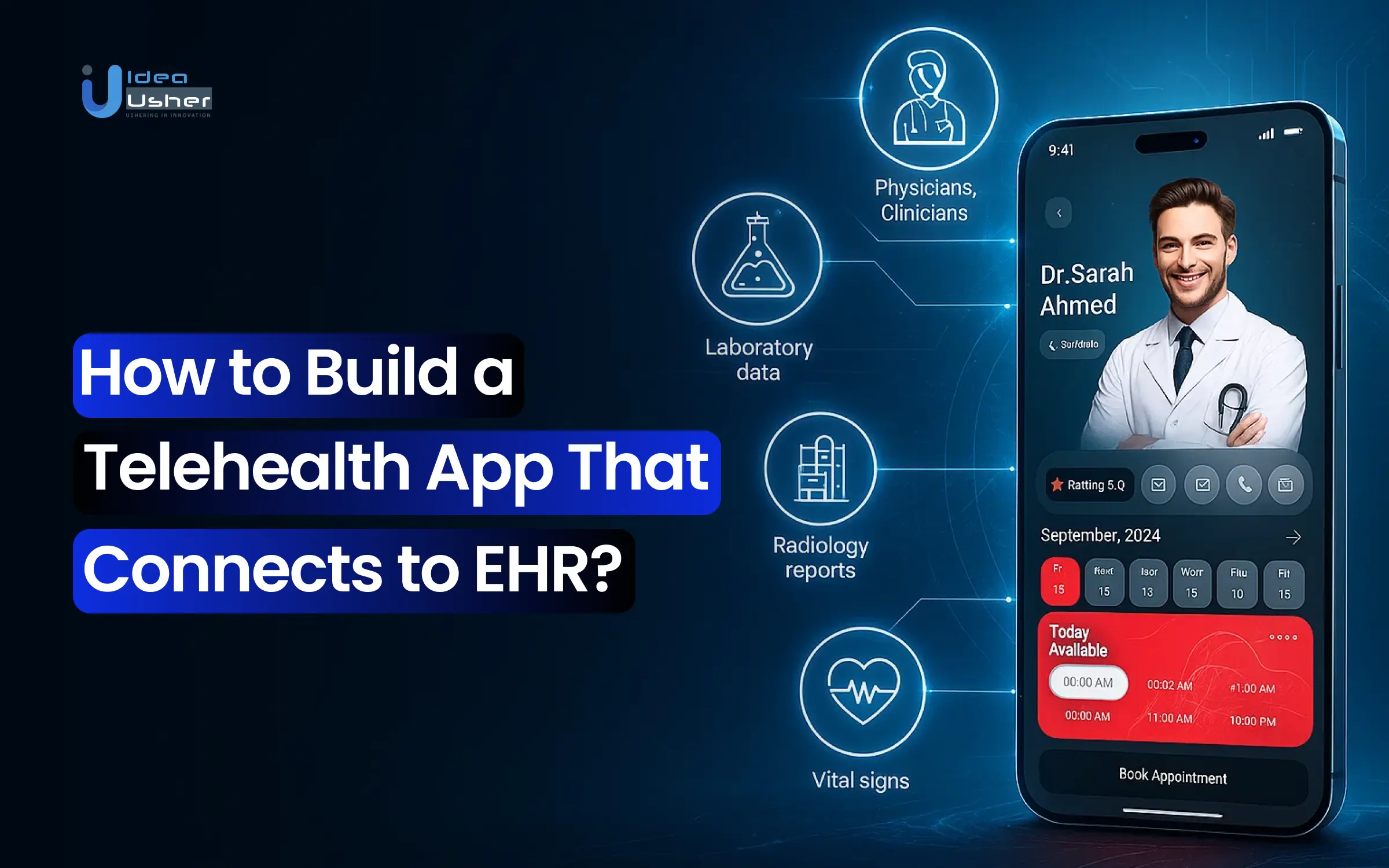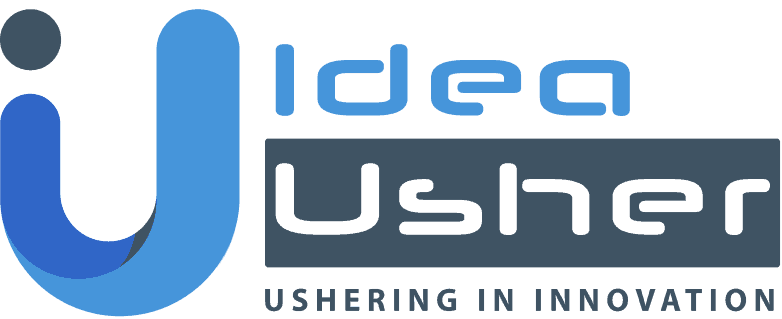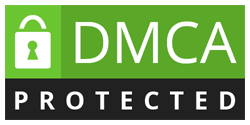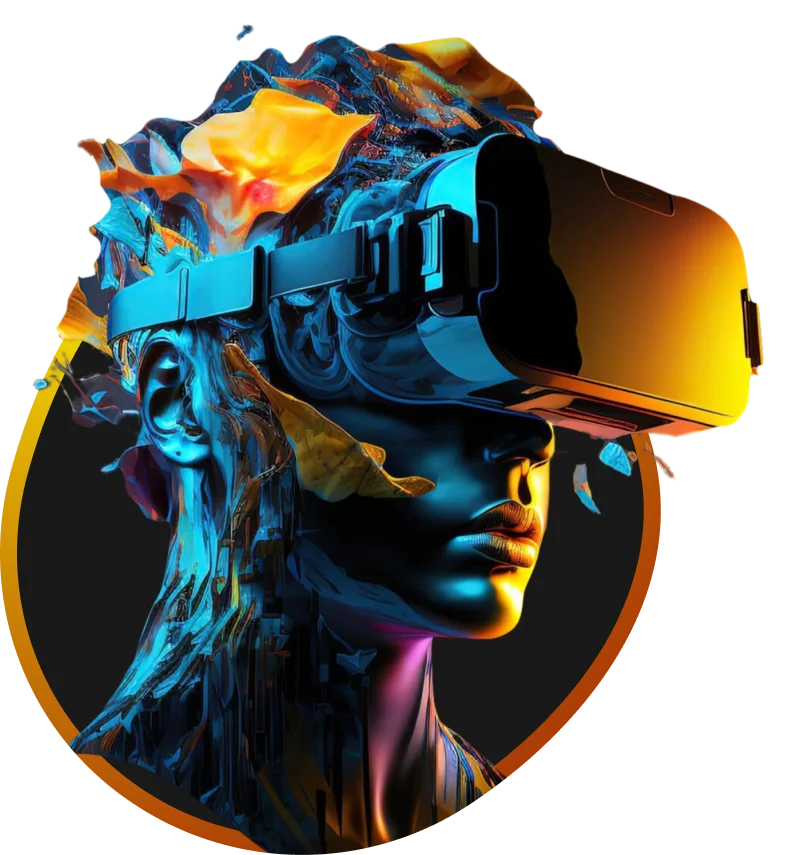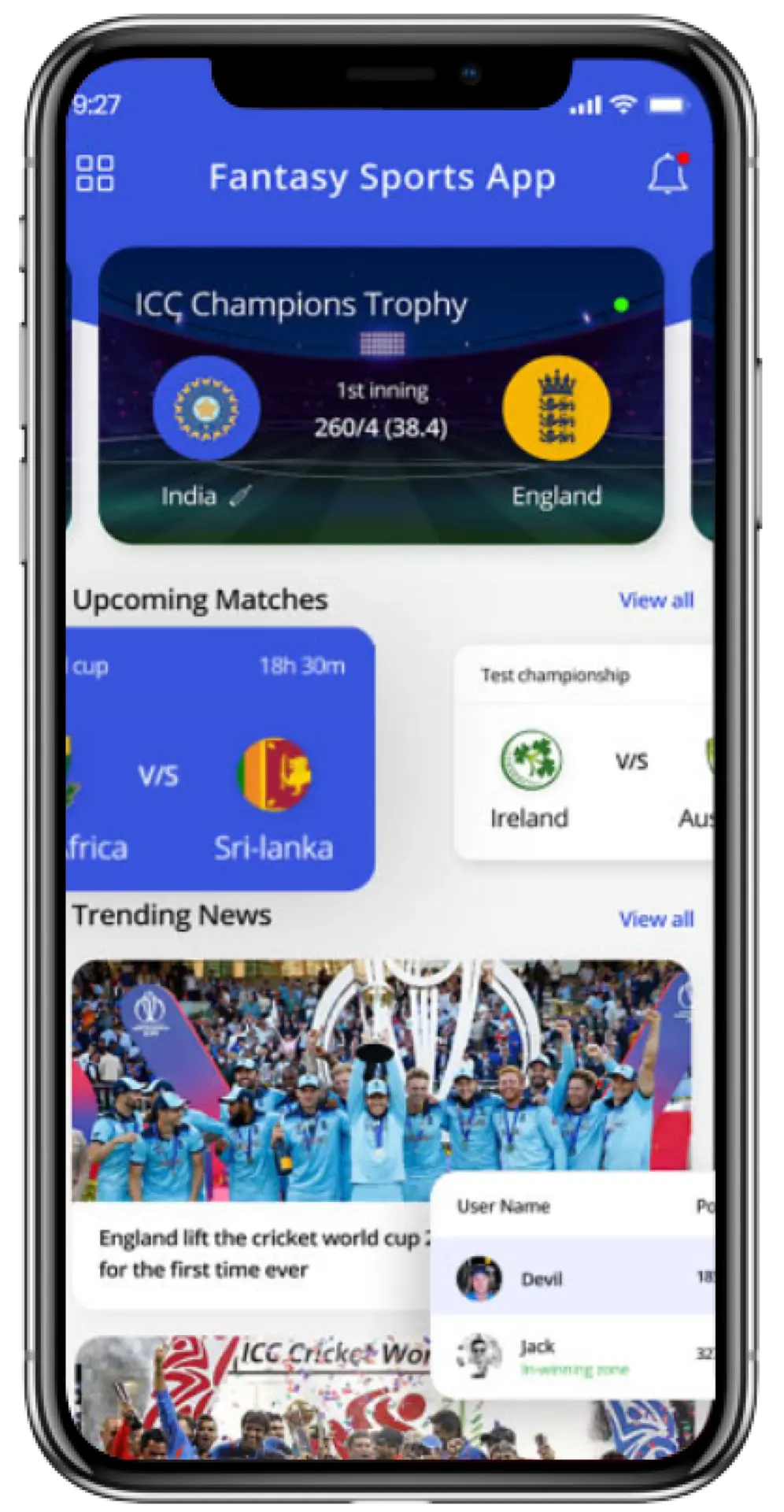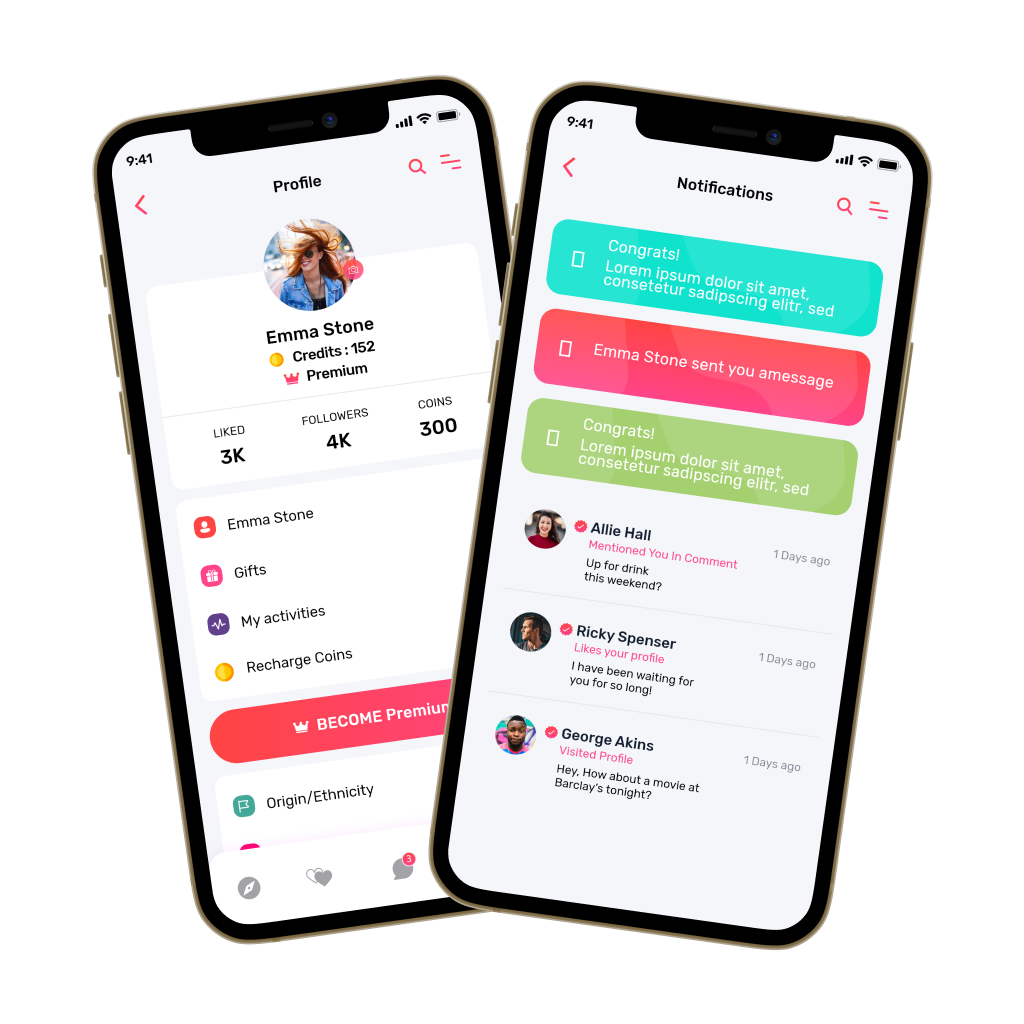Telehealth has become an essential part of modern healthcare, enabling patients to access medical care remotely, especially when in-person visits aren’t feasible. Combining telehealth apps with EHR systems creates an opportunity to improve patient care by giving healthcare providers instant access to patient data. This integration can boost care quality, lower errors, and increase overall patient satisfaction by ensuring smooth communication between patients and providers. Developing a telehealth app that connects to EHR systems requires a solid understanding of both telemedicine and data interoperability.
In this blog, we will understand the concept of EHR, FHIR, and the benefits of EHR-connected telehealth applications. We will also discuss the development process, required technology stacks, and the challenges during the development, and how our developers will solve those, as we have worked with many healthcare enterprises to launch their applications. IdeaUsher has the expertise to develop the telehealth app that connects to EHR systems, ensuring seamless integration, compliance, and enhanced patient care.

Why You Should Invest in EHR-Integrated Telehealth Apps?
The global electronic health record (EHR) apps market was estimated at USD 783.22 million in 2023 and is projected to grow at a CAGR of 8.87% from 2024 to 2030. This growth is driven by the increasing adoption of telemedicine solutions and the need for integrated EHR systems that streamline patient data management and improve healthcare delivery.
Amwell, a leader in telehealth solutions, has raised $500 million from investors including Anthem, Philips, and Teva Pharmaceuticals. This funding highlights the growing demand for telehealth apps that leverage EHR integration to enhance patient care and operational efficiency.
Tebra, an app modernizing independent healthcare practices, raised $72 million in Series B funding, bringing its total funding to over $137 million. Tebra integrates with EHR systems to improve data exchange and enhance patient care, showcasing the market interest in seamless EHR-telehealth integration.
CareCloud, an integrated EHR and telemedicine platform, achieved $117 million in revenue, providing a comprehensive suite of healthcare services, including EHR and telehealth capabilities. CareCloud demonstrates the increasing demand for integrated solutions that simplify workflows and improve patient engagement.
The healthcare industry is undergoing a digital transformation with a shift toward more efficient, data-driven solutions. Investing in EHR-integrated telehealth apps puts stakeholders ahead in a growing market that combines the benefits of telemedicine with comprehensive patient record management. With the adoption of EHR and telehealth solutions on the rise, this space offers substantial growth opportunities for investors and innovators alike.
Understanding the Core Concepts: EHR, FHIR, and SMART on FHIR
As the healthcare industry shifts toward digital transformation, understanding the foundational concepts that enable interoperability and seamless data exchange between systems is crucial. Here, we explore EHR, FHIR, and SMART on FHIR key technologies that serve as the backbone for modern healthcare data management and telehealth applications.
What is an EHR System?
An EHR (Electronic Health Record) system is a digital version of a patient’s paper medical chart that healthcare providers use to manage patient data. It includes detailed information about a patient’s health history, diagnoses, treatments, medications, allergies, test results, and more. Unlike traditional paper records, an EHR is designed to be shared across different healthcare settings, allowing healthcare providers to access and update the record in real-time.
What is FHIR?
FHIR (Fast Healthcare Interoperability Resources) is a modern standard for exchanging healthcare information electronically. Developed by HL7 (Health Level 7), FHIR is designed to simplify the way healthcare data is shared and integrated across systems, such as Electronic Health Records (EHRs), apps, and other healthcare applications.
What is SMART on FHIR?
SMART on FHIR is an extension of the FHIR standard that provides a framework for creating secure, interoperable healthcare applications that can work across various health systems. SMART stands for Substitutable Medical Applications, Reusable Technologies.
Why These Standards Matter for Telehealth Apps
- Enterprise Relevance: EHR, FHIR, and SMART on FHIR are foundational for enterprise healthcare solutions, enabling telehealth apps to connect seamlessly with existing healthcare systems. Telehealth providers can leverage these standards to create scalable, secure, and compliant systems that support multi-provider and multi-location care delivery.
- Compliance: These standards ensure that telehealth apps comply with regulatory frameworks like HIPAA and GDPR, which are critical for protecting patient privacy and ensuring secure data exchange. SMART on FHIR, in particular, ensures that patient data is accessed securely through OAuth 2.0 authentication and role-based access control.
- Scalability: FHIR is designed to scale with the growing demands of digital healthcare. Whether you’re expanding a telehealth service across multiple regions or integrating new third-party apps, FHIR ensures that data can be accessed quickly, accurately, and securely, enabling telehealth apps to handle large volumes of data and users.
- Standardized Communication: These standards ensure that telehealth apps can communicate seamlessly with different EHR systems, eliminating the silos in healthcare data. By leveraging FHIR’s modular approach and SMART on FHIR’s app interoperability, telehealth solutions can be integrated into various clinical workflows, enhancing care delivery and improving patient outcomes.
Key Benefits of EHR-Connected Telehealth Apps
As telehealth expands, integrating it with EHR systems is vital for better patient care, efficient workflows, and compliance. EHR-connected telehealth apps add value by improving decision-making, enhancing patient experience, ensuring compliance with regulations, and cutting costs. Key benefits of these integrations include:
1. Improved Clinical Decision-Making
Accessing real-time medical data such as lab results, medication lists, and imaging, allows healthcare providers to make faster and more informed decisions during telehealth consultations. With telehealth EHR integration, clinicians can adjust treatment plans and make accurate diagnoses, reducing errors and improving patient outcomes.
2. Seamless Patient Experience
By integrating EHRs with telehealth platforms, patients no longer need to repeatedly provide their medical information. Auto-filled forms and reduced redundancies ensure smoother interactions. The integration allows various providers to access the same patient data, improving care coordination and ensuring a more cohesive healthcare experience for patients.
3. Regulatory Compliance & Data Security
Ensuring HIPAA and HL7 compliance is critical when handling patient data. FHIR-based integration supports secure data exchanges with strong encryption, authentication, and access control. Through telehealth EHR integration, healthcare organizations can ensure that patient data is safely managed while adhering to stringent regulatory requirements.
4. Reduced Operational Overhead
By automating administrative tasks such as appointment scheduling and patient record updates, telehealth platforms integrated with EHR systems reduce manual entries and enhance efficiency. These improvements minimize errors, streamline workflows, and free up time for clinicians, allowing them to focus on more critical aspects of patient care.
5. Stronger Patient-Provider Relationships
When EHR-connected telehealth apps provide access to a patient’s full health history, clinicians can create personalized treatment plans. For instance, reviewing a diabetic patient’s medication adherence and glucose levels prior to consultation ensures a tailored approach, strengthening relationships and improving patient satisfaction through a data-driven treatment process.

Step-by-Step Process to Build an EHR-Integrated Telehealth App
Building a telehealth app that integrates with Electronic Health Records (EHR) systems is a comprehensive process that requires careful planning, development, and testing. Below is a step-by-step guide on how to develop a telehealth app with seamless EHR integration, ensuring security, compliance, and effective data interoperability.
1. Consultation
To ensure the success of your telehealth app, our developers will work closely with you to define key functionalities such as video consultations, appointment scheduling, and patient record access. We’ll incorporate telehealth EHR integration with systems like Epic or Cerner, ensuring compliance with HIPAA and GDPR. This guarantees that sensitive patient data is securely managed while the app functions efficiently across various healthcare settings, enhancing user experience and operational workflows.
2. Choose the EHR System
We’ll help you assess the most suitable telehealth EHR integration options based on your healthcare provider’s needs. Whether integrating with Epic, Cerner, or other EHR vendors, we will focus on evaluating key factors like data-sharing capabilities, API compatibility, and scalability. By selecting the right system, we ensure seamless data exchange and real-time information access, which is vital for efficient patient care and enhanced decision-making.
3. Use SMART on FHIR to Connect The App to the EHR
Our development team will implement SMART on FHIR for secure and efficient integration with your EHR system. Using the OAuth2 protocol, we will establish secure authentication, ensuring only authorized users, patients, and clinicians can access sensitive health data. This integration enables your telehealth app to seamlessly retrieve clinical data such as medications, lab results, and appointments, all while ensuring compliance with healthcare standards and patient privacy regulations.
4. Build Core Telehealth App Features
Our team will design and build essential telehealth features, including secure video consultations, appointment scheduling, and real-time access to patient records. By integrating telehealth EHR integration, we ensure that physicians can update prescriptions, clinical notes, and monitor patient progress directly within the app. This provides a holistic care experience, enabling clinicians to manage their workflows efficiently while ensuring that patient information is always up-to-date and easily accessible.
5. Implement Data Interoperability Logic
We’ll ensure that your app is capable of managing and exchanging data effectively across multiple platforms through telehealth EHR integration. By mapping FHIR resources to the app’s data structure, we guarantee smooth data flow, whether it’s patient records, lab results, or prescriptions. Our team will also implement synchronization logic to handle potential conflicts and ensure real-time updates of patient information, ensuring that your app remains accurate, consistent, and reliable.
6. Test for Integration, Security, and Compliance
Before launching, our team will conduct extensive testing to ensure that telehealth EHR integration works seamlessly with your selected EHR system. We will perform sandbox testing, penetration tests, and compliance audits, ensuring the app meets HIPAA, GDPR, and other regulations. This testing ensures that sensitive data is protected, the app functions correctly, and your telehealth solution is ready for deployment with optimal security and reliability for both providers and patients.
Common Challenges and How to Overcome Them?
Integrating telehealth apps with EHR (Electronic Health Records) systems offers significant potential for improving patient care and streamlining healthcare workflows. However, this process is not without its challenges. Below are the most common hurdles faced when integrating EHR systems with telehealth apps, along with strategies to overcome them.
1. Data Standardization Issues
Challenge: Integrating EHR systems with telehealth apps faces data standardization issues due to various formats and structures used across healthcare platforms. Discrepancies in codes like ICD-10 and SNOMED CT can create errors during data exchange, complicating the integration process.
Solution: We will leverage FHIR standards for data integration, ensuring consistent and structured data exchange. By utilizing data transformation tools like ETL platforms, we will convert varied formats into FHIR-compliant formats, ensuring smooth telehealth EHR integration across different systems.
2. Authorization & Access Barriers
Challenge: Ensuring secure access control is difficult when integrating telehealth apps with EHRs. HIPAA compliance mandates strict data access protocols, and managing user authentication across multiple systems introduces complexity, especially when dealing with external parties like specialists.
Solution: To solve this, we will implement OAuth2 for secure authentication and use SMART on FHIR to handle authorization for data access. By applying role-based access control (RBAC), we ensure that only authorized users can access sensitive information, ensuring compliance in telehealth EHR integration.
3. Latency and Real-Time Sync
Challenge: Delays in real-time synchronization during telehealth consultations can hinder decision-making and reduce the quality of patient care. Telehealth apps may struggle to sync data quickly with EHR systems, affecting workflows and operational efficiency.
Solution: We will optimize RESTful APIs for telehealth EHR integration, ensuring low-latency data retrieval. Caching mechanisms will pre-load critical data, and asynchronous syncing will be implemented for non-essential data to improve performance, ensuring real-time access during consultations.
4. EHR Vendor Restrictions
Challenge: Many EHR vendors impose restrictions on third-party integrations, particularly regarding API access and data sharing, which limits the ability to fully integrate telehealth apps with their systems and hinders interoperability.
Solution: To overcome this, we will work directly with EHR vendors, such as Epic and Cerner, to leverage middleware platforms for telehealth EHR integration. By utilizing standardized protocols like FHIR and SMART on FHIR, we can bypass some vendor-specific limitations and ensure seamless integration.
5. Compliance Risks
Challenge: Compliance with regulations like HIPAA and GDPR is critical when handling sensitive healthcare data. Failing to meet these standards during telehealth EHR integration can lead to severe legal consequences and loss of patient trust.
Solution: We will implement end-to-end encryption, audit logging, and data minimization practices to ensure compliance with HIPAA and GDPR standards. Regular compliance audits will verify that all integrated systems maintain secure data transmission and meet necessary regulatory requirements.
Tools, APIs, and Frameworks You’ll Need
When developing a telehealth app that integrates with EHR systems like Epic or Cerner, various tools, APIs, and frameworks are needed for data interoperability, secure communication, and backend functions. These enable seamless integration, improve security, and simplify development. Here’s an overview of essential tools and frameworks for building a successful telehealth app.
1. FHIR API (HL7)
FHIR (Fast Healthcare Interoperability Resources) is the key data standard for healthcare interoperability. It allows telehealth apps to exchange patient data with EHR systems and healthcare providers seamlessly. Using FHIR API (developed by HL7), your app can integrate patient records, clinical data, medication histories, and appointments into a unified framework. FHIR provides a standardized structure for sharing healthcare data securely and efficiently, making it a critical tool for building EHR-connected telehealth apps.
2. SMART on FHIR Authorization (OAuth2.0)
SMART on FHIR is a protocol that builds on FHIR to enable secure app-layer interoperability with EHR systems. It utilizes OAuth 2.0 for authentication and authorization, ensuring that third-party apps can access sensitive patient data only with explicit user consent. This standard is crucial for managing patient access rights and ensuring that only authorized users (e.g., healthcare providers, patients) can access or modify clinical data.
3. Epic App Orchard / Cerner Open Developer Portal
Epic App Orchard and Cerner Open Developer Portal are the official developer platforms provided by leading EHR vendors Epic and Cerner, respectively. These portals offer access to APIs, sandbox environments, and documentation needed to build, test, and deploy apps that integrate with their EHR systems.
4. Google Cloud Healthcare API / Microsoft Azure API for FHIR
Both Google Cloud Healthcare API and Microsoft Azure API for FHIR provide cloud-based healthcare data management solutions. These APIs allow developers to manage and process FHIR-compliant healthcare data in a scalable, secure environment. They offer support for storing, analyzing, and sharing data between systems while ensuring compliance with HIPAA and other regulatory standards.
5. Twilio / Vonage (For Secure Video Calling)
Twilio and Vonage are cloud communication platforms that provide secure video calling services essential for telehealth consultations. These platforms offer APIs that enable developers to integrate HD video calls into their telehealth app, ensuring that patient-provider interactions are seamless, secure, and compliant with healthcare regulations like HIPAA.
6. Firebase / AWS Amplify (For App Backend, Auth, and Storage)
Firebase (by Google) and AWS Amplify (by Amazon) are cloud-based backend-as-a-service (BaaS) platforms. They provide developers with powerful tools for authentication, data storage, real-time databases, and app hosting. These platforms also offer scalable infrastructure, allowing apps to grow and manage high volumes of traffic seamlessly.
7. Postman / Insomnia (For API Testing)
Postman and Insomnia are popular tools used for API testing. These platforms help developers test the FHIR APIs and ensure that their telehealth app integrates smoothly with the EHR system. They allow developers to make requests to the API endpoints, check responses, and debug issues during the development process.
Use Case Example: Integrating a Virtual Clinic App with Epic EHR
A mid-size virtual care provider seeks to improve live video consultations by allowing doctors to view comprehensive patient histories in real-time. They aim to integrate their virtual clinic app with Epic EHR so physicians can access records, lab results, and e-prescriptions during consultations, enhancing decision-making and patient experience.
Implementation:
To successfully integrate the virtual clinic app with Epic EHR, the provider followed these steps:
- The team utilized Epic App Orchard to access the sandbox environment for testing integration, ensuring security and privacy compliance without using live data.
- Developed a React Native application with integrated SMART on FHIR login, facilitating secure OAuth2.0 authentication for physicians to seamlessly access patient data from Epic EHR.
- The app’s interface combines patient history, lab results, and e-prescriptions using Epic EHR’s FHIR APIs, supporting real-time access to vital info and helping providers make informed decisions during consultations.
Result:
Integrating Epic EHR with the telehealth app improved clinical efficiency, diagnosis accuracy, patient care, and outcomes.
- The app provided physicians with instant access to patient history and test results, reducing the need to search records and increasing efficiency. This lowered consultation time by 30%, allowing the clinic to see more patients while delivering quality care.
- With real-time access to patient records, including lab results and medications, physicians made more informed decisions. This resulted in a twofold increase in diagnosis accuracy, reducing errors and enhancing patient care outcomes.
Conclusion
Building a telehealth app that connects to EHR systems creates a seamless bridge between remote healthcare and patient data management. This integration improves communication between healthcare providers and patients, leading to better care coordination, timely interventions, and more informed decision-making. By ensuring real-time access to patient information, such apps enhance the overall healthcare experience and reduce errors. As the demand for remote healthcare continues to grow, the ability to connect telehealth apps with EHR systems will remain a critical component in delivering high-quality, efficient, and accessible care for patients and providers alike.
Why Choose IdeaUsher for Your Telehealth App Development?
At IdeaUsher, we specialize in developing telehealth apps that seamlessly integrate with EHR systems to improve patient care and operational efficiency. Whether you are building a telemedicine platform, virtual healthcare services, or an online consultation app, our team ensures smooth integration with EHR systems to ensure accurate and real-time patient data access.
Why Work with Us?
- Telehealth & EHR Integration Expertise: Our team has extensive experience in integrating telehealth apps with leading EHR platforms like Epic and Cerner, ensuring seamless communication between doctors, patients, and healthcare providers.
- Custom Solutions: From the concept stage to full deployment, we offer tailored solutions for your telehealth needs, ensuring the app fits the specific requirements of your practice or organization.
- Proven Success: We’ve helped companies like Vezita, Mediport, Allied Health Platform, etc., successfully build telehealth apps that integrate with EHR systems, enhancing patient care and streamlining workflows.
- Scalable & Secure: We develop scalable and secure apps that adapt as your healthcare business grows, ensuring long-term viability and compliance with industry standards.
Explore our portfolio to see how we’ve worked with businesses to create telehealth solutions that seamlessly connect with EHR systems.
Reach out today for a free consultation, and let us help you develop a telehealth app that integrates with EHR systems to provide high-quality care and streamline healthcare operations!
Work with Ex-MAANG developers to build next-gen apps schedule your consultation now
FAQs
Key features include secure video consultations, real-time access to patient records, appointment scheduling, e-prescriptions, and billing integration. These functionalities ensure seamless communication between healthcare providers and patients, enhancing the quality of remote care.
Data security is ensured through end-to-end encryption, secure authentication protocols like OAuth 2.0, and compliance with HIPAA regulations. Regular security audits and adherence to best practices safeguard patient information during telehealth sessions and EHR access.
Challenges include ensuring interoperability between different EHR platforms, maintaining data consistency, and addressing technical issues related to API integrations. Overcoming these requires thorough planning, collaboration with EHR vendors, and robust testing procedures.
EHR integration provides patients with seamless access to their medical history, lab results, and treatment plans during telehealth consultations. This comprehensive view enables more personalized care, reduces redundant tests, and improves overall patient satisfaction.
